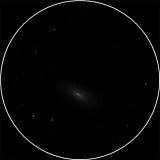
| MESSIER 81 |
|---|
RA: |
09h 55m 36s |
|
DEC: |
+69° 04' 00'' |
|
Type: |
Spiral galaxy |
|
NGC: |
3031 |
|
Magnitude: |
6.90 |
|
Surface brightness : |
13.20 |
|
Apparent dimensions : |
24.9'x11.5' |
|
Distance: |
12,000,000 ly |
|
M81 is one of the easiest and most rewarding galaxies to observe for the amateur astronomer on the northern hemisphere, because with its total visual brightness of about 6.8 magnitudes it can be found with small instruments. There are reports that M81 is visible by naked eye in exceptionally good viewing conditions. The pronounced grand-design spiral galaxy M81 forms a most conspicuous physical pair with its neighbor, M82, and is the brightest and probably dominant galaxy of a nearby group called M81 group. M81 is the first of the four objects originally discovered by Johann Elert Bode, who found it, together with its neighbor M82, on December 31, 1774. Bode described it as a "nebulous patch", about 0.75 deg away from M82, which "appears mostly round and has a dense nucleus in the middle," and included it as No. 17 in his list. Pierre Méchain independently rediscovered both galaxies as nebulous patches in August 1779 and reported them to Charles Messier, who added them to his catalog after his position measurement on February 9, 1781. Visually, the M81 is easy to observe. In low power telescopes it it possible to see M81 together with M82 in same field of view. Very close is third spiral galaxy, NGC 3077, which is reasonably bright and should be visible in telescopes larger than 4". Traces of spiral arms can be seen in 12" telescopes and larger under good viewing conditions. |
||
Other sketches |
|||||
 |
|||||
M81, Jan 2006. |
|||||
VEDRAN VRHOVAC© 2006.-2007. |
